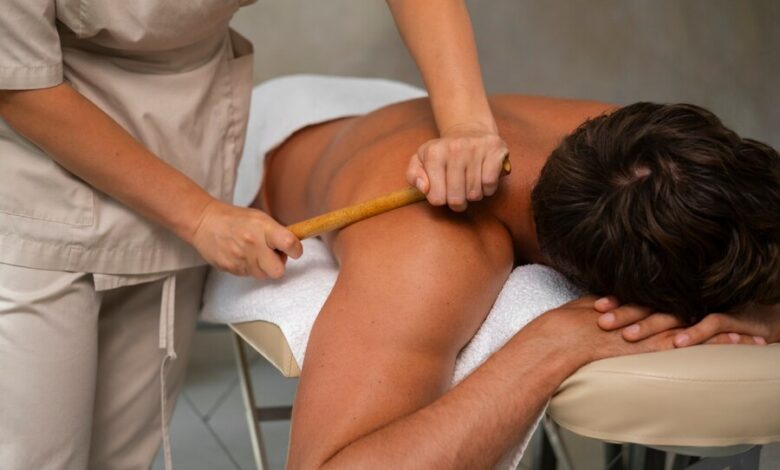Shiatsu Massage: A Deep Dive into the Healing Art
Originating from Japan, Shiatsu offers a unique approach to healing



In today’s fast-paced world, many people are looking for natural, effective ways to reduce stress and promote overall wellness. One such technique that has stood the test of time is Shiatsu massage. Originating from Japan, Shiatsu offers a unique approach to healing by combining touch, pressure, and movement to balance the body and mind.
What is Shiatsu Massage?
Shiatsu is a traditional Japanese form of bodywork that uses finger, thumb, and palm pressure along specific pathways on the body, known as meridians. These meridians are thought to correspond to the flow of vital energy, or Qi (pronounced “chee”). The goal of Shiatsu massage is to stimulate the body’s natural healing abilities by encouraging the flow of energy and alleviating blockages.
Unlike Western massage techniques, which tend to focus on muscles and tissues, Shiatsu takes a holistic approach. It works with the body’s energy system to promote balance and well-being. Shiatsu practitioners often use rhythmic pressure to stimulate specific points and help align the body’s energy, ensuring the body’s natural harmony.
The Origins of Shiatsu
The word “Shiatsu” comes from the Japanese language, with “shi” meaning finger and “atsu” meaning pressure. Shiatsu massage has been influenced by both traditional Chinese medicine (TCM) and Japanese healing practices. Initially, Shiatsu was based on Anma, a Japanese form of therapeutic massage, but it evolved into its distinct style during the 20th century.
Shiatsu’s relationship with TCM is also significant. In TCM, the concept of Qi is central to health. Qi is believed to flow through the body via energy channels called meridians. By stimulating these points, Shiatsu aims to restore the balance of energy, which can improve health and alleviate pain.
The Benefits of Shiatsu Massage
Shiatsu massage provides numerous benefits that extend far beyond relaxation. Some of the key benefits include:
- Stress Relief and Relaxation: One of the most popular reasons people seek Shiatsu is for stress reduction. The deep, rhythmic pressure used during the massage can help activate the body’s parasympathetic nervous system, which induces relaxation and reduces tension.
- Pain Management: Shiatsu has been found to help with various pain conditions, including back pain, neck pain, and headaches. The pressure applied to specific points along the body can relieve muscle tension and improve circulation.
- Improved Circulation: By working on specific meridians, Shiatsu helps to increase blood flow and promote the body’s natural detoxification process.
- Boosted Immune System: Regular Shiatsu massage can help strengthen the immune system by improving lymphatic circulation and promoting the body’s overall health.
- Emotional Balance: Shiatsu not only works on the physical body but also helps to release emotional blockages. This can lead to improved mood and emotional stability.
How Shiatsu Massage Works: Techniques and Practices
Shiatsu uses various techniques, including:
- Finger and Thumb Pressure: These are the primary techniques used in Shiatsu, focusing on applying pressure to specific points along the body’s meridians.
- Palm Pressure: Using the palms of the hands, the practitioner applies broad pressure to larger areas of the body.
- Stretching and Mobilization: Shiatsu also involves gentle stretches and manipulations of the body to help improve flexibility and promote relaxation.
- Rotational Movements: The practitioner may use subtle rotational movements on joints and muscles to help release tension and improve circulation.
The beauty of Shiatsu lies in its adaptability. The pressure can be adjusted according to the client’s comfort level, making it suitable for people of all ages and conditions. It is a non-invasive technique, which makes it a great choice for those who want to experience the benefits of massage without intense pressure.
Shiatsu Massage vs. Other Massage Types
While there are many types of massage therapies available, Shiatsu offers something distinct. Here’s how it compares to other popular types of massage:
- Shiatsu vs. Swedish Massage: Swedish massage is a more gentle technique that primarily focuses on relaxation, whereas Shiatsu works more deeply with energy points to target specific ailments. Shiatsu is also performed on the floor, while Swedish massage is typically done on a table.
- Shiatsu vs. Deep Tissue Massage: Deep tissue massage focuses on working through muscle layers to relieve chronic tension, while Shiatsu uses pressure along the energy pathways of the body. Shiatsu’s primary aim is balancing energy, whereas deep tissue massage is more focused on relieving physical tension.
- Shiatsu vs. Acupressure: Acupressure is similar to Shiatsu in that it targets specific pressure points, but Shiatsu involves more movement and stretching. Acupressure is more stationary, while Shiatsu often involves dynamic techniques to improve circulation and flexibility.
Who Can Benefit from Shiatsu Massage?
Shiatsu massage is beneficial for almost anyone, regardless of age or condition. It’s particularly helpful for individuals who suffer from chronic stress, anxiety, or physical discomfort. Here’s a list of people who can benefit from Shiatsu:
- Individuals with Stress and Anxiety: The calming effects of Shiatsu can help alleviate emotional tension and anxiety, making it an excellent choice for those seeking mental clarity and peace.
- Athletes: Shiatsu’s focus on muscle relaxation and improved circulation can help athletes recover after intense physical activity. It can also improve flexibility and range of motion.
- Office Workers: People who sit at desks for long periods can benefit from Shiatsu’s ability to relieve neck, shoulder, and back tension. The massage also helps promote relaxation and mental clarity.
- Elderly Individuals: Shiatsu is gentle enough to be beneficial for older adults, helping to relieve joint stiffness, improve circulation, and promote overall well-being.
- Those with Chronic Pain: Shiatsu’s ability to target pain points in the body makes it ideal for those dealing with chronic pain conditions, such as arthritis or fibromyalgia.
How to Find a Shiatsu Practitioner
If you’re interested in experiencing Shiatsu massage, it’s important to find a qualified practitioner. Here are some tips for finding a good Shiatsu therapist:
- Look for Certification: A qualified Shiatsu practitioner should be certified by a recognized organization. Look for those who have undergone formal training.
- Check Reviews: Online reviews and testimonials can give you insight into the quality of a therapist’s services.
- Consultation: Many Shiatsu practitioners offer a consultation to discuss your needs and explain their approach. This can help ensure you’re comfortable with the practitioner and their techniques.
- Ask About Experience: If you have specific concerns or conditions, it’s helpful to work with a practitioner who has experience addressing similar issues.
Conclusion: Why Shiatsu Massage Should Be Part of Your Wellness Routine
Incorporating Shiatsu massage into your regular wellness routine can offer profound benefits, from relieving stress and improving circulation to alleviating chronic pain. Its holistic approach focuses on the body’s energy system, which sets it apart from other massage therapies. Whether you’re seeking relaxation or trying to address specific health concerns, Shiatsu offers a natural, effective solution for maintaining balance and well-being.



